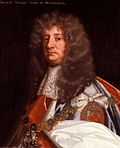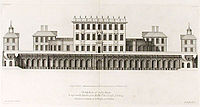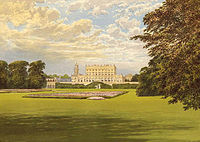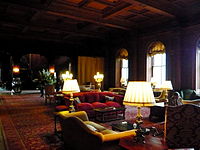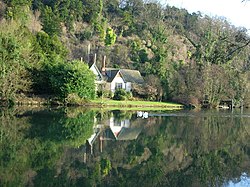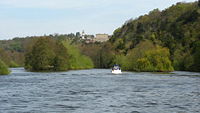Cliveden
Cliveden is an Italianate mansion and estate at Taplow in Buckinghamshire. Set on banks 131 feet above the River Thames, its grounds slope down to the river. The site has been home to an Earl, three Countesses, two Dukes, a Prince of Wales and the Viscounts Astor.
As home of Nancy Astor, the house was the meeting place of the Cliveden set of the 1920s and 1930s—a group of political intellectuals. Later, during the 1960s, it became the setting for key events of the notorious Profumo Affair. During the 1970s, it was occupied by Stanford University of California, which used it as an overseas campus. Today owned by the National Trust, the house is leased as a five-star hotel run by London & Regional Properties.
Cliveden means "valley among cliffs"[1] and refers to the dene (valley) which cuts through part of the estate, east of the house. Cliveden has been spelled differently over the centuries, some of the variations being Cliffden, Clifden, Cliefden and Clyveden.[2] The 375 acre gardens and woodlands are open to the public, together with parts of the house on certain days. There have been three houses on this site: the first, built in 1666, burned down in 1795 and the second house (1824) was also destroyed by fire, in 1849. The present Grade 1 listed house was built in 1851 by the architect Charles Barry for George Sutherland-Leveson-Gower, 2nd Duke of Sutherland.
Contents
Present house
Designed by Sir Charles Barry in 1851 to replace a house previously destroyed by fire, the present house is a blend of the Palladian style and the Roman Cinquecento.[3] The Victorian three-story mansion sits on a brick terrace or viewing platform 400 feet long and 20 feet high (visible only from the south side) which dates from the mid-seventeenth century. The exterior of the house is rendered in Roman cement, with terracotta additions such as balusters, capitals, keystones and finials. The roof of the mansion is meant for walking on, and there is a circular view, above the tree-line, of parts of Buckinghamshire and Berkshire, including Windsor Castle to the south.[4]
Below the balustraded roofline is a Latin inscription which continues around the four sides of the house and recalls its history; it was composed by the then prime minister Gladstone. On the west front it reads: "POSITA INGENIO OPERA CONSILIO CAROLI BARRY ARCHIT A MDCCCLI", which translated reads: "The work accomplished by the brilliant plan of architect Charles Barry in 1851".[5] The main contractor for the work was Lucas Brothers.[6] In 1984–86 the exterior of the mansion was overhauled and a new lead roof installed by the National Trust, while interior repairs were carried out by Cliveden Hotel.[7]
Clock tower
The nearby 100-foot clock tower was added in 1861 and is the work of the architect Henry Clutton. As a functioning water tower it still provides water for the house today. It is rendered in Roman cement like the rest of the house, and features four clock faces framed by gilded surrounds and a half open staircase on its north side. It was described by the architectural critic Nicholas Pevsner as "the epitome of Victorian flamboyance and assertiveness."[8] The tower is topped with a modern reproduction of Augustin Dumont's 19th century winged male figure Le Génie de la Liberté (the Spirit of Liberty). The original is atop the July Column in the Place de la Bastille, Paris. This replaces two earlier versions, the first having fallen from the tower during a storm in the 1950s. The new statue is made of bronze and was created using Dumont's original mould from the 1860s found in a museum in Semur-en-Auxois, France.[9] It is an allegorical sculpture which holds the torch of civilization in its right hand and the broken chain of slavery in its left. It was affixed to the tower in spring 2012.
Early history
Cliveden stands on the site of a house built in 1666 designed by architect William Winde as the home of George Villiers, 2nd Duke of Buckingham. But before Buckingham's purchase the land was owned by the Mansfield family and before that to the de Clyveden family.[10]
The details are recorded in a document compiled by William Waldorf Astor in 1894 called "The Historical Descent of Cliveden". It shows that in 1237 the land was owned by Geoffrey de Clyveden and by 1300 it had passed to his son, William, who owned fisheries and mills along the Cliveden Reach stretch of the Thames and at nearby Hedsor.
The document also shows that in 1569 a lodge existed on the site along with 50 acres of land and was owned by Sir Henry Manfield and later his son, Sir Edward. In 1573 there were two lodges on 160 acres of treeless chalk escarpment above the Thames. It was on this impressively high but exposed site that Buckingham chose to build the first Cliveden House.
Buckingham pulled down the earlier buildings and chose William Winde as his architect. Winde designed a four-storey house above an arcaded terrace. Today, the terrace is the only feature of Buckingham's house to survive the 1795 fire. Although the Duke's intention was to use Cliveden as a "hunting box" he later housed his mistress Anna, Countess of Shrewsbury there. In the Duke's Garden, immediately to the east of the house, flints have been laid in the lawn in the pattern of a rapier with the date 1668 to commemorate the duel between the Duke and his mistress's husband Lord Shrewsbury.[11] The event which took place at Barn Elms near London resulted in Shrewsbury’s dying of his wounds. A contemporary account of Buckingham's antics with Anna is recounted by Samuel Pepys in his diary of the period.
John Evelyn, another contemporary diarist, visited the Duke at Cliveden on the 22nd of July 1679 and recorded the following impression in his diary:
I went to Clifden (sic) that stupendous natural Rock, Wood & Prospect of the Duke of Buckinghams, & building of extraordinary expense... tis a romantic object & the place altogether answers the most poetical description that can be made of a solitude, precipice, prospect & whatever can contribute to a thing so very like their imagination. The house stands somewhat like Frascati... on the platform is a circular view of the utmost verge of the Horizon which with the serpentining of the Thames is admirably surprising... the Cloisters, Descents, Gardens & avenue through the wood august and stately."[12]
18th century
1st Earl of Orkney
After Buckingham's death in 1687 the house remained empty until the estate was purchased by George Hamilton, 1st Earl of Orkney in 1696. Orkney was a general in the Battle of Blenheim (1704) and later governor of the Colony of Virginia without ever setting foot on American soil. The Earl employed the architect Thomas Archer to add two new "wings" to the house, connected by curved corridors. Although an almost identical arrangement exists today, these are later reconstructions, the originals having been destroyed in the fire of 1795. All that remains of Archer's work inside the house today is a staircase in the west wing.
Orkney's contributions to the gardens can still be seen today, most notably the Octagon Temple and the Blenheim Pavilion, both designed by the Venetian architect Giacomo Leoni. The landscape designer Charles Bridgeman was also commissioned to devise woodland walks and carve a rustic turf amphitheatre out of the cliff-side.
Frederick, Prince of Wales
Between 1737 and 1751 the estate was leased to Frederick, Prince of Wales by Orkney's heirs after his death. From 1737 till 1824, the 2nd, 3rd and 4th Countesses of Orkney and their respective families owned and (usually) occupied Cliveden. It was sold in 1824.[13] Frederick, Prince of Wales, son and heir of King George II, fell out with his father and Cliveden enabled him to withdraw from life at the royal court. At Cliveden he established a family home for his wife Augusta and their children. It was during the Prince's tenure of the house that Rule, Britannia! (an aria by the composer Thomas Arne) was first performed in public in the cliff-side amphitheatre at Cliveden on 1 August 1740. It was played as part of a masque to celebrate the third birthday of his daughter, Augusta.
It is believed that it was at Cliveden in 1751 that the Prince received a blow to the chest from a cricket ball while playing in the grounds; the resulting infection proved fatal.[14]
After his death, Frederick's family left Cliveden and the estate was once again used by Orkney's heirs until the night of 20 May 1795 when the house caught fire and burned down. The cause of the fire was thought to have been a servant knocking over a candle.[14]
19th century
Sir George Warrender
After the fire of 1795 the house remained a ruin for the first quarter of the 19th century until, in 1824 the estate was purchased by Sir George Warrender, 4th Baronet. To rebuild Cliveden, Warrender selected William Burn as architect and decided on a design for a two-storey mansion designed with entertaining on a grand scale in mind.
George, 2nd Duke of Sutherland
Warrender died in 1849 and the house was sold to the Sutherland family, headed by the second Duke. Sutherland had been in possession of the estate for only a few months when the house burned down for the second time in its history. The cause this time appears to have been negligence on the part of the decorators.[15]
The Duke was prompt in commissioning the architect Charles Barry to rebuild Cliveden in the style of an Italianate villa. Barry, whose most famous project is the Palace of Westminster, was inspired by the outline of the two earlier houses for his design. The third (and present) house on the site was completed in 1851-52, and its exterior appearance has little changed since then. The 100-foot-tall clock tower, which is actually a water tower (still working to this day) was added in 1861 by the architect Henry Clutton. Also around this time another architect, George Devey, was commissioned to build half-timbered cottages on the estate along with a dairy and boathouse.
After the duke's death in 1861, his widow Harriet continued to live at the house for part of the year until her death in 1868, after which it was sold to her son-in-law Hugh Lupus, Earl Grosvenor, later 1st Duke of Westminster.
1st Duke of Westminster
When one lives in Paradise, how hard it must be to ascend in heart and mind to Heaven.—Lady Frederick Cavendish on Cliveden, June 1863.[16]
Westminster was one of the wealthiest men of the period[17] so it is understandable that he would want to contribute to Cliveden's architecture. Among his additions to the house and gardens are the porte cochère on the north front of the mansion, a new stable block and the dovecote, all designed by Henry Clutton.
Astor era
In 1893 the estate was purchased by a very wealthy American, William Waldorf Astor (later 1st Lord Astor), who made sweeping alterations to the gardens and the interior of the house, but lived at Cliveden as a recluse after the early death of his wife. He gave Cliveden to his son Waldorf on the occasion of his marriage to Nancy Langhorne in 1906 and moved to Hever Castle. Nancy Astor later became the first woman to sit in the House of Commons.
The young Astors used Cliveden for entertaining on a lavish scale.[18] The combination of the house, its setting and leisure facilities offered on the estate—boating on the Thames, horse riding, tennis, swimming, croquet and fishing—made Cliveden a destination for film stars, politicians, world-leaders, writers and artists. The heyday of entertaining at Cliveden was between the two World Wars when the Astors held regular weekend house parties. Guests at the time included: Charlie Chaplin, Winston Churchill, Joseph Kennedy, George Bernard Shaw, Mahatma Gandhi, Amy Johnson, F.D. Roosevelt, H.H. Asquith, T.E. Lawrence (Lawrence of Arabia), Arthur Balfour and the writers Henry James, Rudyard Kipling, and Edith Wharton. The tradition of high-profile guests visiting the house continues to this day, largely due to the house's conversion into a hotel.[19]
There is a ghastly unreality about it all ... I enjoy seeing it. But to own it, to live here, would be like living on the stage of the Scala theatre in Milan.—Harold Nicolson after a visit to Cliveden in 1936.[20]
Also at this time the entertainer Joyce Grenfell, who was Nancy Astor's niece, lived in a cottage on the estate.[21] She also entertained injured troops in the hospital on the estate during Second World War.
At the outbreak of the First World War, Waldorf Astor offered the use of some of the grounds to the Canadian Red Cross for the building of a hospital—the HRH Duchess of Connaught Hospital—which was dismantled at the end of the hostilities. In September 1939 with the outbreak of Second World War Waldorf Astor again offered the use of the land at a rent of one shilling per year to the Canadian Red Cross and the Canadian Red Cross Memorial Hospital was built to the designs of Robert Atkinson. After the war the hospital's main focus was as a nursing school, a maternity unit and a rheumatology unit until the hospital closed in the early 1980s.
Attached to the military hospital and within the grounds was established Cliveden War Cemetery. There are 42 Commonwealth war graves, 40 from World War I (mostly Canadians) and two from Second World War, besides two American service war graves from the first war.[22]
In 1942, the Astors gave Cliveden to the National Trust with the proviso that the family could continue to live in the house for as long as they wished. Should this cease, they expressed the wish that the house be used "for promoting friendship and understanding between the peoples of the United States and Canada and the other dominions".[23] With the gift of Cliveden, the National Trust also received from the Astors one of their largest endowments. The Astors ceased to live at Cliveden in 1968, shortly after the Profumo Affair and Bill Astor's death.
Interior
The interior of the house today is very different from its original appearance in 1851–52. This is mainly due to the 1st Lord Astor who radically altered the interior layout and decoration c. 1894–95. Whereas Barry's original interior for the Sutherlands had included a square entrance-hall, a morning room and a separate stairwell, Lord Astor wanted a more impressive entrance to Cliveden so he had all three rooms knocked into one large one (the Great Hall). His aim was to make the interior as much like an Italian palazzo as possible, which would complement the exterior. The ceiling and walls were panelled in English oak, with Corinthian columns and swags of carved flowers for decoration, all by architect Frank Pearson. The staircase newel posts are ornamented with carved figures representing previous owners (e.g. Buckingham and Orkney) by W.S. Frith. Astor installed a large sixteenth-century fireplace, bought from a Burgundian chateaux which was being pulled down. To the left of the fireplace is a portrait of Nancy, Lady Astor by the American portraitist John Singer Sargent. The room was and still is furnished with eighteenth-century tapestries and suits of armour. Originally the floor was covered with Minton encaustic tiles (given to the Sutherlands by the factory) but Nancy Astor had them removed in 1906 and the present flagstones laid.[24] Above the staircase is a painted ceiling by French artist Auguste Hervieu which depicts the Sutherland's children painted as the four seasons. This is the only surviving element of Barry's 1851–2 interior and it is believed that Lord Astor considered it too beautiful to remove.
The French Dining Room is so called because the eighteenth-century Rococo panelling (or boiseries) came from the Chateau d'Asnieres near Paris, a chateau which was leased to Louis XV and his mistress Madame de Pompadour as a hunting lodge. When the panelling came up for sale in Paris in 1897, the 1st Lord Astor recognised that it would exactly fit this room at Cliveden. The gilded panelling on a turquoise ground contains carvings of hares, pheasants, hunting dogs and rifles. The console tables and buffet were made in 1900 to match the room. The main dining room of the house until the 1980s, today it is a private dining room with views over the Parterre and Thames.
The second largest room on the ground floor, after the Great Hall, was the drawing room which today is used as the hotel's main dining room. This room, which has views over the Parterre and Thames, was redecorated in 1995 by Eve Stewart, with terracotta-coloured walls, gilded columns and trompe-l'œil shelves of books. The ceiling is painted to resemble clouds and three Bohemian glass chandeliers hang from it. The portraits in the room include the 2nd Duke of Sutherland, the 1st Lord Astor, and Miss Mary Hornack by Sir Joshua Reynolds.
Also on the ground floor is the library, panelled in cedar wood, which the Astors used to call the "cigar box",[25] and, next door, Nancy Astor's boudoir. Upstairs are five bedrooms and on the second floor another five. The East wing was and still is guest accommodation, whereas the West wing was domestic offices but in 1994 these were converted into more bedrooms. The National Trust tour only includes the Great Hall and French Dining Room.
Cliveden Hotel
In 1984 Blakeney Hotels (later Cliveden Hotel Ltd) acquired the lease to the house. Led by chairman John Lewis and managing director John Tham they restored and refurbished the interior.[26] Rooms are furnished with Edwardian antiques and the house is run in a similar style as it would have been when Nancy Astor was chatelaine.
Gardens and grounds
The estate extends to 375 acres of which about 180 acres comprise the gardens, the rest being woodland and paddocks.
Parterre
The formal parterre to the south of the house is one of the largest in Europe at 4 acres.[27] and is best viewed from the 20-foot high terrace on the south side of the mansion. This part of the garden has received the most attention over the centuries. The first arranging of the large plateau to the south of the house took place c.1723 during George Hamilton, Earl of Orkney's ownership.[28]
At the far end there was (and still is) a sunken feature in the turf where Orkney's horses were exercised in a form of open-air manège.[29] Orkney referred to the garden as his "Quaker parterre" because of its simplicity.[30] The parterre endured in this form until the mid 19th-century when the estate was owned by the Duke of Sutherland and by which time the garden had been neglected. It was described by the Duke's son Lord Ronald Gower as "a prairie...a huge field of grass and wild flowers."[31] The Duke commissioned both Charles Barry (who had rebuilt the mansion after the second fire) and John Fleming (the head gardener) to produce designs for a complex parterre of flower beds. Fleming's design, which featured two sets of eight interlocking wedge-shaped beds, was chosen and is the template for what can be seen today.[32] The beds were planted with a seasonal mix of bulbs, annuals and shrubs such as gladioli, hollyhocks, tulips, pansys and azaleas. Fleming pioneered this style of planting at Cliveden, which was later to be named "carpet-bedding."[33] The Cliveden scheme in the 19th-century is well documented in Fleming's handbook Winter and Spring Flower Gardening (1864). The Trust planted the present clipped yew pyramids at the corners of the beds in 1976 but in 2010 decided to recreate Fleming's original nineteenth-century planting scheme.
Themed gardens
The Italian-style Long Garden consists of topiary in the form of corkscrew-spirals, peacocks and box hedges. The Japanese-style Water Garden was laid out by the 1st Lord Astor in c.1893 and is believed to be the first such oriental-inspired garden in the country.[34] The original Rose Garden, designed by Sir Geoffrey Jellicoe for the Astor family in the early 1960s has since suffered from rose disease and has been replanted as a "secret" garden of herbaceous plants.
In 2011 the Trust began an ambitious project to restore the 19th-century Round Garden near the eastern edge of the estate. Originally this is where fruit was grown for the house but since the 1950s it has laid overgrown. The circular garden has a diameter of 250 ft and restoration will include reinstating the paths and wrought iron arches as well as original fruit varieties where possible.
Woodland
There is a lime tree avenue either side of the main drive to the house. Cliveden holds part of the National Plant Collection of Catalpa.[35] In 1897 the 1st Lord Astor imported a section of a Californian redwood and had it installed in the woods. At 16ft 6in across it is the largest section of a Sequoia gigantea in Britain.[36] The woodlands were first laid out by Lord Orkney in the eighteenth century on what had been barren cliff-top; they were later much restocked by Bill Astor but suffered badly in the Great Storm of 1987. The National Trust continues the re-planting of the beechwoods.
Maze
The original Cliveden maze, commissioned by Lord Astor in 1894, has undergone major restoration after having lain overgrown and inaccessible since the 1950s. It was replanted with 1,100 six-foot-tall yew trees covering an area of one third of an acre and opened to the public in 2011.[37]
Temples, pavilions and follies
The Blenheim Pavilion (c.1727) was built to commemorate Orkney's victory as a general at the Battle of Blenheim. The Octagon Temple, situated two-hundred feet above the Thames, was originally designed as a gazebo and grotto but was later converted by the 1st Lord Astor to become the family chapel. Its interior and dome are decorated with colourful mosaics. The pagoda in the water garden was made for the Paris Exposition Universelle of 1867 and was purchased by the 1st Lord Astor from the Bagatelle estate in Paris in 1900. In the woods there is a small flint folly thought to date from the mid-nineteenth century.
Borghese balustrade
The largest sculpture in the grounds, technically in two parts, is the 17th-century Borghese Balustrade on the parterre. Purchased by Lord Astor in the late 19th century from the Villa Borghese gardens in Rome, it is crafted from Travertine stone and brick tiles by Giuseppe Di Giacomo and Paolo Massini in c.1618-19. It features seats and balustrading with fountain basins and carved eagles.
Spring Cottage
This is the largest and most complex of the four timber-framed cottages designed or altered by the architect George Devey along the banks of the River Thames on the Cliveden estate. The first structure on the site was a Gothick-style summerhouse with an octagonal vaulted plaster ceiling designed in 1813 by architect Peter Nicholson for Mary, 4th Countess of Orkney.[38] She was living in one wing of the burnt down mansion at the time of the commission. It was used as a tea house and spa for the many visitors attracted to the nearby mineral springs, which flowed from the chalk cliff above and ran down into the Thames.[39] Nicholson published his designs for the house in his Architectural Dictionary of 1813 in the form of a cross-section of the interior and ceiling projection. In auction particulars dated 1821, which list all structures on the estate, the building is described as a Banqueting house "at the much admired spring",[40] whilst several decades later it was described as an "ornamental fishing villa."[41] In 1857 the Duke of Sutherland, who had owned Cliveden for eight years, commissioned George Devey to enlarge the existing building into a two-storey cottage.[42] The subsequent alterations were in the vernacular style with brick and stucco walls, fish-scale pattern roof slates, a Gothick-style loggia and a turret above an exterior staircase leading to a balcony.[43] Throughout the remainder of the 19th century the main function of the cottage was as a place of leisure and was frequently used by the Duke's wife Harriet to entertain guests, most notably her friend Queen Victoria.[44]
In 1957 the cottage came to the attention of London osteopath Stephen Ward who had been hired to treat Bill Astor. He leased the cottage from the Astors for a minimal rent for use as a weekend retreat.[45] Among the guests invited to stay there were London call girls Christine Keeler and Mandy Rice-Davies.[46] A chance meeting in 1961 between Keeler and cabinet minister John Profumo (a guest of the Astors) at the Cliveden swimming pool led to what was subsequently called the Profumo Affair which in turn led to the fall of the Macmillan government.[47]
Spring cottage was awarded Grade II listed status in 1986.
In popular culture
Film and television
- Thunderbirds (2004); Cliveden is used as the location for Lady Penelope's house, "Creighton-Ward Mansion".
- ’’Mrs. Henderson Presents (2005)
- Yaadein (2001 Bollywood film), uses the house and grounds
- Help! (1965; the second Beatles film), the scenes that were supposed to be in Buckingham Palace were filmed at Cliveden
- Carry On Don't Lose Your Head
- The Card (1952); horse and carriage sequences in were filmed on the drive
- The Thames at Cliveden appears in both Chaplin (1992) and Carrington (1995).
- Cliveden's panelled library stands in for a priest's New York study in the 2008 film Made of Honor.
- The Yellow Rolls-Royce
- In 2000 the BBC Antiques Roadshow used the grounds as a venue for a valuation day.
- Scandal (1989), story of the Profumo affair, is inspired by events which took place at Cliveden, but is not filmed there.
- The main gates appear in the 1978 film Death on the Nile.
- The interior and exterior of Spring Cottage appears in ITV's Cards on the Table (2005).
- The French Dining room stands in for a hotel bedroom in Sherlock Holmes (2009).
- The house appears as itself in the 1982 BBC TV series Nancy Astor.
- The garden and interior of Spring Cottage and surrounding riverside location are used in the film Dead Man's Folly (1986).
- Operation Daybreak’’, 1975 war film, it appears as the Czech HQ
Literature
- In Chapter 12 of Three Men in a Boat (1889), Jerome K. Jerome describes Cliveden Reach as "unbroken loveliness this is, perhaps, the sweetest stretch of all the river…"
- In Boogie Up the River (1989) Mark Wallington retraces Jerome's journey to mark its centenary, with the Thames at Cliveden described in Chapter 5.
- The poet Alexander Pope wrote (c. 1730) of the Duke of Buckingham's affair with Anna, Countess of Shrewsbury: "Gallant and gay in Cliveden's proud alcove/The bower of wanton Shrewsbury and love."[48]
- Daniel Defoe mentions the first house in A Tour Through England and Wales (1726).
- Gore Vidal in his 1948 novel The City and the Pillar: "The Cliveden-Churchill Set are too well entrenched and I shouldn't be in the least surprised if they created some sort of dictatorship that could never be thrown off without a revolution."
Gallery
Outside links
| ("Wikimedia Commons" has material about Cliveden) |
- Location map: 51°33’31"N, 0°41’18"W
- nationaltrust.org.uk Cliveden information at the National Trust
- Cliveden House Hotel
- National Trust Collections: an online directory of items at Cliveden
- The Anglo-American Establishment: From Rhodes to Cliveden by Carroll Quigley
References
- ↑ Room, Adrian (1992). Brewer's Dictionary of Names: People Places and Things. Brewer. p. 118. ISBN 978-1-85986-232-2.
- ↑ Crathorne 1995, p. 10
- ↑ Crathorne, 1995, p.29.
- ↑ Crathorne 1995, p. 206
- ↑ National Trust 1994, p. 66
- ↑ N.T. Guide, 1994, p.30.
- ↑ N.T. Guide, 1994, p.46.
- ↑ Pevsner, N. The Buildings of England: Buckinghamshire, London, 1960, p.48
- ↑ Ibid
- ↑ Crathorne, 1995, p.10.
- ↑ National Trust Guide Cliveden, 2012, p.3
- ↑ quoted in Crathorne, Cliveden, London, 1995, pp12-13
- ↑ National Trust Guide, National Trust U.K.. "Clivedon National Trust Guide". Ownership / Occupants of Cliveden -Family of Earl of Orkney. National Trust U.K..
- ↑ 14.0 14.1 N.T. Guide, 1994, p.19
- ↑ N.T. Guide, 1994, p.28.
- ↑ Quoted in Crathorne, 1995, frontispiece.
- ↑ N.T. Guide, 1994, p.36.
- ↑ N.T. Guide, 1994, p.42.
- ↑ Crathorne, 1995, p.213.
- ↑ Quoted in N.T. Guide, 1994, p.45.
- ↑ N.T. Guide, 1994, p.26
- ↑ CWGC Cemetery Report.
- ↑ Crathorne 1995
- ↑ National Trust 1994, p. 42
- ↑ Crathorne, 1995, p.181.
- ↑ Crathorne 1995, p. 202
- ↑ Llewellyn 1989, p. 123
- ↑ NT Guide, Cliveden, 1994, pp.48-49
- ↑ NT GUIDE, Cliveden, 1994. p.69
- ↑ NT Guide, Cliveden, 1994, pp48-49
- ↑ Crathorne, Cliveden, 1995, p.99
- ↑ NT Guide, Cliveden, 2012, p.16
- ↑ NT Guide, Cliveden, 2012, p.16
- ↑ Quest-Ritson, The English Garden, London, 2001, p.202
- ↑ National Trust 1994, p. 76
- ↑ National Trust 1994, p. 77
- ↑ RHS website. Last accessed 16/03/12]
- ↑ Spring Cottage article at IHBC.org
- ↑ Ibid
- ↑ quoted in Crathorne, Cliveden, 1995, p79
- ↑ Ibid, IHBC.org
- ↑ Ibid, IHBC
- ↑ National Heritage List 1125050: Cliveden
- ↑ Ibid, IHBC.org
- ↑ Ibid, Crathorne, p.184
- ↑ Ibid
- ↑ Ibid, Crathorne, p.185
- ↑ Alexander Pope, Moral Essays
Books
- Crathorne, James (1995), Cliveden: The Place and the People, London
- Llewellyn, R (1989), Elegance and Eccentricity
- National Trust, The (1971), Guide to Cliveden, London: National Trust for Places of Historic Interest or Natural Beauty
- National Trust, The (1994), Guide to Cliveden, London: National Trust for Places of Historic Interest or Natural Beauty
- Astor, Michael, Tribal Feeling, London, 1963.
- Coates, Tim, The Scandal of Christine Keeler and John Profumo: Lord Dennings Report 1967, London, 2003.
- Fox, James, The Langhorne Sisters, London, 1998.
- Hayward, Allyson, Norah Lindsay: The Life and Art of a Garden Designer, London,2007.
- Jackson-Stopps, Gervase, An English Arcadia, London, 1992.
- Keeler, Christine, The Truth at Last: My Story, London, 2002.
- Lacey, Steven, Gardens of the National Trust, London, 1994.
- Rose, Norman, The Cliveden Set: Portrait of an Exclusive Fraternity, London, 2000.
- Sinclair, David, Dynasty: The Astors and their Times, London, 1983.
- Stanford, Peter, Bronwen Astor: Her Life and Times, London, 2001.


